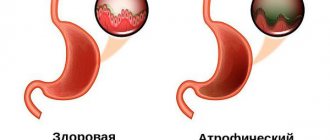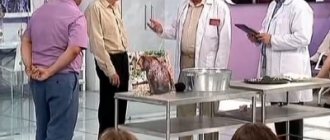At least one big feast in a series of New Year's holidays is already over, which means clients with a burning sensation in the esophagus have already made their way to the nearest pharmacy. Overeating and heavy doses of alcohol almost inevitably lead to problems with the gastrointestinal tract, even for those who do not normally suffer from this. Pharmacy workers who celebrate the holiday are required to dispense “something for heartburn.” How to answer the strangest or trickiest questions from clients about antacids? We offer you the following answer options.
Recommend me something for heartburn that will last longer.
Modern antacid drugs that are not absorbed in the digestive tract, such as aluminum phosphoric acid or aluminum-magnesium drugs, are suitable for you. They bind hydrochloric acid quite quickly - usually within a few minutes after ingestion - and their effect lasts up to several hours. Maximum duration of action
characteristic of drugs containing aluminum hydroxide. They act for 2.5–3 hours [2].
Popular questions and answers
We discussed with gastroenterologist Elena Mezentseva the issues of first aid for heartburn, its potential causes and the admissibility of self-medication for this condition.
Why does heartburn occur?
Heartburn is a burning sensation behind the sternum from bottom to top. It occurs due to the reflux of acid from the stomach into the esophagus. This happens due to increased pressure in the stomach and abdominal cavity due to overeating, errors in diet (rich, fatty foods), drinking alcohol, carbonated drinks, physical stress, taking a horizontal body position, and bending forward. Between the stomach and esophagus there is a locking sphincter that prevents stomach contents from flowing back into the esophagus. All “transport” food flows are directed from top to bottom, and when this pattern breaks down and reverse flows appear, which are called refluxes, heartburn occurs. In most cases, these are acidic reflux (that is, the contents of the stomach), but there are also bile and alkaline reflux (the contents of the duodenum, which contains bile, pancreatic juice, etc.).
What to do if heartburn occurs?
Heartburn is a sign of acid-related diseases, such as gastroesophageal reflux disease, gastric ulcer, diaphragmatic hernia, and dyspepsia. That is, if heartburn appears, it means there is a problem and it needs to be solved. You can drink a glass of water or milk. Take well-known and often advertised drugs, such as Maalox, Gaviscon, etc. But these are temporary measures that provide quick, but, unfortunately, short-term relief, because they treat the effect, not the cause.
Give me heartburn medicine. And it would be desirable to also help with bloating - are there any such remedies?
Yes, today there are combination drugs that simultaneously neutralize hydrochloric acid and stop the manifestations of flatulence due to the inclusion of simethicone in the antifoam composition. It reduces the surface tension of gas bubbles in the digestive tract, promoting their rupture. An example of such a drug is a combination of aluminum, magnesium hydroxide and simethicone in the form of a suspension. It simultaneously neutralizes hydrochloric acid, reduces gas formation in the intestines, and also envelops the mucous membrane of the digestive tract, protecting it from the damaging effects of aggressive substances [5].
Antacids: understanding the myths and misconceptions
All antacids work the same way.
For example, absorbable antacids (sodium bicarbonate, calcium carbonate) act very quickly, but do not last long, can cause rebound syndrome, and with frequent use lead to alkalosis (alkalinization).
The effect of non-absorbable drugs (magnesium and aluminum hydroxides) does not develop so quickly, but persists for 3–4 hours; antacids of this group have a cytoprotective effect on the gastric mucosa. Among antacids, there are drugs that can neutralize not only hydrochloric acid, but also pepsin and bile acids, as well as regulate intestinal motility, improve the regeneration of ulcers and erosions. So the effect of such different antacids cannot be called the same.
Antacids are the only cure for heartburn.
Heartburn, i.e. a burning sensation behind the sternum occurs when the acidic contents of the stomach are thrown into the esophagus and causes a chemical burn of its mucous membrane. To cope with heartburn, you can use antacids, or you can solve this problem with the help of drugs from other medicinal groups.
For example, with frequent relapses of heartburn against the background of acid-related diseases, H2-histamine receptor blockers and proton pump inhibitors are recommended, which can suppress the formation of hydrochloric acid and thereby prevent the occurrence of heartburn.
As an alternative to antacids, alginates (alginic acid salts) can be used, which form a gel when interacting with acidic gastric juice. A layer of gel on the surface of the stomach contents prevents reflux and protects the mucous membrane from heartburn. In some cases (with peptic ulcers, chronic gastroduodenitis and gastritis), the use of gastroprotectors - bismuth preparations, sucralfate, etc. - is more effective for treating heartburn.
Instead of antacids, it is better to use regular baking soda.
Baking soda, or sodium bicarbonate, very quickly reduces the acidity of gastric juice, but this effect lasts only a few minutes, because. in response to a sharp change in gastric pH, rebound syndrome develops - a secondary increase in the secretion of hydrochloric acid. As a result, the acid content in the gastric juice increases, irritation of the mucous membrane and heartburn intensify. This is also facilitated by the accumulation of carbon dioxide in the stomach, which is released when sodium bicarbonate reacts with hydrochloric acid. The gas stretches the walls of the stomach, provokes the development of acid reflux and increases pain. If in this situation a person takes a new dose or even several, this can lead to systemic side effects - nausea, vomiting, headache and swelling. The use of soda is especially dangerous for patients with kidney disease and cardiovascular pathologies.
Antacids help with heaviness, belching or fullness of the stomach.
Many patients perceive antacids as drugs that “help the stomach.” And they are trying to use them not only to relieve heartburn, but also as a first aid when symptoms of gastric dyspepsia appear - a feeling of fullness after eating, heaviness in the stomach, flatulence and belching of air. But the basis for the development of these unpleasant sensations is not the excessive secretion of hydrochloric acid. The cause may be impaired gastrointestinal motility, increased sensitivity of visceral receptors and impaired nervous regulation of the stomach, insufficient activity of digestive enzymes and other functional disorders. Taking antacids in such a situation will only help eliminate heartburn, but will not affect all other symptoms. And if there is no heartburn, then taking antacids is useless. In some cases, it can even be harmful, for example, if dyspepsia is associated with low acidity of gastric juice. Therefore, to treat the symptoms of dyspepsia, it is recommended to use prokinetics, enzyme preparations and agents that reduce gas formation in the gastrointestinal tract.
For gastritis and peptic ulcers, antacids are useless.
Antacids, although not basic therapy drugs, are very widely used in the treatment of acid-related diseases. Firstly, for gastric ulcers and hyperacid gastritis, antacids are considered one of the most effective symptomatic remedies that can quickly eliminate heartburn, acid reflux and ulcerative hunger pain during the next exacerbation. Secondly, antacids are the main means of “emergency” care, which the patient can independently use “on demand”, i.e. without a doctor's prescription. And thirdly, the use of antacids as part of complex antiulcer therapy increases the effectiveness of treatment and promotes faster healing of ulcers and erosions. If the course of peptic ulcer disease is favorable (rare and short-lived exacerbations, absence of large ulcers), antacids can even be prescribed as monotherapy. For moderate peptic ulcers, antacids complement the course of taking antisecretory drugs. Also, the use of antacids can be recommended as a method of preventing seasonal exacerbations of acid-related diseases.
Antacids have no side effects.
Almost every drug has side effects, as well as contraindications that limit the possibility of use, and antacids are no exception. When taking absorbable antacids, symptoms of alkalosis may occur - loss of appetite, nausea, vomiting, abdominal pain, headache, increased blood pressure. When using non-absorbable antacids - constipation or diarrhea, nausea, impaired phosphorus and calcium metabolism, impaired renal function. The risk of side effects is especially high with long-term regular use of antacids. Therefore, in all cases when a person is forced to continuously take drugs of this group for more than 2 weeks, it is necessary to consult a doctor and carry out treatment only under his supervision. In addition, it must be taken into account that antacids reduce the absorption of many drugs. So there must be a gap of at least 2 hours between taking antacids and any other medications.
Antacids suppress digestion.
When used as directed and in recommended therapeutic doses, not a single modern antacid drug has a negative effect on the process of food digestion in the stomach and intestines. Even with continuous use, antacids are not able to completely neutralize the entire volume of hydrochloric acid formed in the stomach.
With the use of antacids, the acidity of gastric juice is reduced to a pH level of 3.0–4.0, at which the process of digestion, enzyme formation and food disinfection proceeds normally. Moreover, the use of antacids in patients with acid-related diseases can improve digestion, as well as intestinal motility and nutrient absorption, which were previously impaired due to excessive acidity of the stomach contents.
Antacids can only be used by adults.
Acid-related diseases also occur in children. Therefore, antacids are very widely used in pediatrics, for example, for gastritis and gastroudodenitis, reflux esophagitis, and functional dyspepsia. In this case, preference is given to non-absorbable combined antacids, which contain aluminum and magnesium salts. This combined composition makes the treatment more effective and reduces the risk of side effects. The most convenient dosage forms for children are suspension and gel, which can be used from 6 years of age. If a child develops situational heartburn, parents can also use one of the antacid medications themselves. But, of course, it is important not to forget that even a one-time occurrence of heartburn in childhood is a serious reason for a visit to the doctor, which should not be postponed for long.
What is the difference between tablets and suspension from heartburn? Do they act differently?
The mechanism of action of a drug does not depend on the form (tablets, gel, suspension), but on its components. But the pharmacokinetic properties - the speed of onset of the effect, the duration of action - may differ between tablets and suspensions. It is believed that tablet forms maintain the acidity of gastric juice longer at a level of more than 4 ( acidity of gastric juice is considered normal in the range of 1.3–7.5 pH - editor's note.
) than suspensions. When chewable tablets for heartburn are taken correctly, acid-neutralizing components enter the digestive tract evenly, which has a positive effect on the result. At the same time, for heartburn, suspensions can begin to work faster than tablets [3]. In addition, they are optimally distributed over the surface of the mucous membrane, and in the lumen of the esophagus and stomach they form small drops with a large surface area, which enhances their medicinal properties [6].
And yet it cannot be said unequivocally that any form has an advantage. To draw such conclusions, you need to consider the properties of a particular drug.
The role of the pharmacist
Unfortunately, in most cases of heartburn, the patient does not reach a doctor. When the first symptoms appear, people prefer to go to the pharmacy and pick up the drug there. Therefore, the pharmacist must know the features of all antacids, the rules for taking them and contraindications in order to give individual, competent advice to each buyer. In addition, the first-calculator needs to inform the client that timely consultation with a doctor in case of frequent heartburn is simply necessary! This will help identify the cause of the symptom, increase the likelihood of cure, and reduce the risk of developing serious complications such as Barrett's esophagus and esophageal cancer.
So, what are antacids and alginates and what place do they occupy in the treatment of acid-related diseases? Let's figure it out.
Bibliography:
- Practical Manual of Gastroesophgeal Reflux Disease /Ed.by Marcelo F. Vela, Joel E. Richter and Jonh E. Pandolfino, 2013 –RC 815.7.M 368
- Danilov D.V. Modern possibilities for the treatment of erosive esophagitis / Danilov D.V., Shuleshova A.G., Bondareva K.A. // Evidence. gastroenterology. - 2022. - T. 6; No. 1. – pp. 26-30.
- Initial and maintenance therapy in patients with gastroesophageal reflux disease / Simanenkov V.I., Tikhonov S.V., Lishchuk N.B. // Med. alphabet. - 2022. - T. 1; No. 9 (306). — P. 8-12.
- INSTRUCTIONS for the use of the medicinal product for medical use OMEZ®10 mg LP 00328 dated 07/11/17 Date of access 11/26/18
- Kardasheva, S. S. Gastroesophageal reflux: new treatment prospects / Kardasheva S. S., Shulpekova Yu O., Leshchenko V. I. // Med. advice. - 2022. - No. 11. - P. 92-99.
- Tarasova, G. N. Pathogenetic features of damage to the mucous membrane of the esophagus during gastroesophageal reflux disease / Tarasova G. N., Smirnova E. A. // Consilium Medicum. - 2017. - T. 19; No. 8-2. — P. 7-12.
- Trukhan, D. I. Current aspects of antisecretory therapy of gastroesophageal reflux disease / Trukhan D. I., Grishechkina I. A. // Med. advice. - 2022. - No. 15. - P. 28-35.







